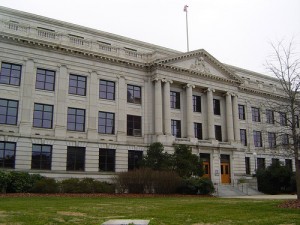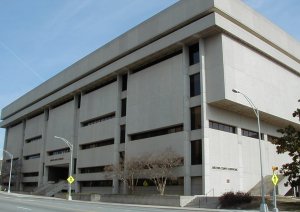The law creating Guilford passed in 1770, and the county started administration of its territory on April 1, 1771. “Old Guilford County” was three times larger than present-day Guilford County, since Randolph County was created from the southern third of Guilford in 1779, and Rockingham County was created from the northern third of Old Guilford in 1785. The first 10 years of court records were burned at the time of the battle on 15 March 1781.
from the Guilford County website:
The Guilford County Court met every Februrary, May, August, and November on the third Monday of the Month. When Guilford County was formed in 1771 a temporary courthouse in western Guilford County along the Deep River on the property of Robert Lindsay was used for three years. In 1774, the Courthouse moved several miles east and the community of Guilford Courthouse grew around the new county seat. One year later the small community was renamed Martinville. The burgeoning township served the county for thirty-four years until Greensboro was formed in spring 1808.
The First Guilford Courthouse – Martinville
“The first of the county’s courthouses was the Guilford Courthouse of Revolutionary fame. Some say it was built of logs while others contend it was of clapboards. Whatever the construction, it was located about 6 miles northwest of the center of present Greensboro. The exact date of its erection is not known, but in 1786 an entry was made in the court records to ‘thoroughly repair courthouse and build pillory and stocks.’ For 20 years this old courthouse was patched and repatched to accommodate needs. Finally in 1807 a majority of the people voted to move the county seat to the middle of the county.
“The county commissioners appointed William Armfield, Isaac Clapp, Nathan Mendenhall, Hugh Starbuck, and George Swain as commissioners to superintend the public buildings on the newly selected site; and in May, 1809, they reported that the new courthouse was ready for the reception of the court in Greensboro. With no fanfare at all, the minutes simply state:
Court adjourned [Thursday, May 18] from the town of Martinville to the town of Greensborough to meet at 10 o’clock tomorrow. Court present at the adjournment …. Friday, 19th, Court met according to adjournment at Greensborough …” — Arnett
The Second Courthouse – Greensborough
There is not total agreement on where court was held from 1809 to 1819. One group says there was a log building courthouse halfway between present Elm and Davie streets on the south side of East Market Street, facing that street. The second group says the location was the original city plot shown on a map. Lyndon Swaim wrote and published a story in 1882 where he said that all courthouses from 1809 to 1858 were at the intersection of Market and Elm streets, and other reliable sources agree with that. The second courthouse was said not to have been built until 1818-1820. It is said to have been been a two-story brick structure. It was in need of major repairs by 1826.
“Courthouses generally were badly abused in those days. Complaint was made of whittling on the chairs, doors, and railings; of writing on the walls; and of using floors as cuspidors. This particular courthouse had a wide hallway through which ‘drunks’ are said to have galloped on their horses, and sober people are reported to have driven horses and wagons from one end of the building to the other. Fortunately, such conduct was not engaged in by the majority of the people, and … an imposing structure was built in 1830 at the very center of town.” — p. 53
The Third & Fourth & Fifth Courthouses
“This third courthouse in Greensboro was a more commodious and pretentious edifice, with a stately Ionic front.” Years later people were objecting to its being in the middle of the business district. So the county bought a lot on the corner of North Elm and Gaston, but ended up building the new courthouse on the former location of Sam Hopkins’ tavern at Elm and West Market. The Greensborough Patriot described the next courthouse this way: “It was built after an elegant design in the Roman-Corinthian stle of brick stuccoed, with a graceful wooden tower … ” In 1872 that courthouse burned. It was replaced with the same building design, except the wooden tower was iron this time.
The old building and its lot were purchased by Jefferson Standard in 1917.
The Sixth Courthouse, 301 West Market Street
The county bought all the lots facing Ashe Street between West Market and Sycamore, and closed Ashe Street, making a new courthouse square. The new courthouse was finished in 1918.
The Seventh Courthouse, 201 South Eugene Street
The modern facility was built to meet current needs, and the previous courthouse is used for county administrative offices.
The High Point Courthouse, 505 East Green Drive
Guilford


